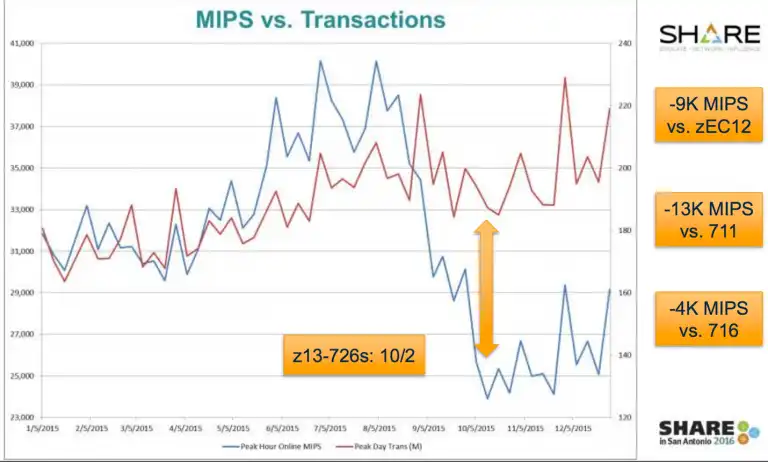While most mainframe shops have explored how to reduce mainframe software costs, at IntelliMagic we are finding significant latent savings opportunities still exist at even the best run sites.
Since software cost reduction is always important, we thought it would be helpful to pass along a valuable resource from the March 2016 SHARE Conference for mainframe users, which included a new session by Todd Havekost of USAA, a Fortune 100 financial services company.
Mr. Havekost’s presentation ‘Achieving Significant Capacity Improvements on the IBM z13’ outlined the results of their software cost optimization initiatives. Part of the story is that some of the historical capacity planning assumptions no longer apply and how lowering RNI reduced both MIPS and the cost of IBM Monthly Licensing Charge (MLC) software. The session has been identified as outstanding and the winner of the SHARE Best Session Award.
The content is an excellent overview of industry-leading optimization efforts, and explores z13 capacity concepts, key processor hardware metrics, and the results for USAA. Our own software, IntelliMagic Vision, is used for numerous charts in his presentation.
Todd’s initiatives resulted in a reduction of 13,000 MIPS for USAA, as documented in the following slide from the presentation:
After the presentation, one of the IBM Distinguished Engineers that attended the presentation said that USAA is the first site he is aware of that has performed this type of detailed z13 performance analysis and optimization.
Because Todd Havekost is one of the country’s leading experts in this area of mainframe software cost reduction, we recently hired Todd to lead the comprehensive MLC optimization initiatives for IntelliMagic customers, using IntelliMagic Vision for z/OS.
“IntelliMagic Vision meets a critical need in today’s mainframe environments by applying embedded subject matter expertise against the rich set of SMF metrics. The result is the ability to proactively identify threats to mainframe availability,” Todd said. ”Best of all, the flexible reporting interface provides unparalleled visibility into performance data to identify system inefficiencies and MLC reduction opportunities.”
Download the full presentation here from the SHARE Conference website to see all 43 slides.
To schedule a no-charge evaluation of the latent software MLC reduction opportunities at your mainframe site, please contact us for a no-obligation review of your environment.
How to use Processor Cache Optimization to Reduce z Systems Costs
Optimizing processor cache can significantly reduce CPU consumption, and thus z Systems software costs, for your workload on modern z Systems processors. This paper shows how you can identify areas for improvement and measure the results, using data from SMF 113 records.
This article's author
Share this blog
Subscribe to our Newsletter
Subscribe to our newsletter and receive monthly updates about the latest industry news and high quality content, like webinars, blogs, white papers, and more.
Related
Why Am I Still Seeing zIIP Eligible Work?
zIIP-eligible CPU consumption that overflows onto general purpose CPs (GCPs) – known as “zIIP crossover” - is a key focal point for software cost savings. However, despite your meticulous efforts, it is possible that zIIP crossover work is still consuming GCP cycles unnecessarily.
Top ‘IntelliMagic zAcademy’ Webinars of 2023
View the top rated mainframe performance webinars of 2023 covering insights on the z16, overcoming skills gap challenges, understanding z/OS configuration, and more!
Making Sense of the Many I/O Count Fields in SMF | Cheryl Watson's Tuning Letter
In this reprint from Cheryl Watson’s Tuning Letter, Todd Havekost addresses a question about the different fields in SMF records having different values.
Book a Demo or Connect With an Expert
Discuss your technical or sales-related questions with our mainframe experts today


 Brent Phillips
Brent Phillips